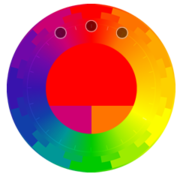Analogous color scheme
Analogous (or adjacent colors) is a color scheme using one base color and two secondary colors placed symetrically around it on the color wheel. The base color is main, while the secondary colors should be used only for highlights and accents. It always looks very elegant and clear. There is no tension in the palette, and typically it’s uniformly all warm, or all cold. If a base color on the warm-cold border is chosen, the color with opposite “temperature” may be used for accenting the other two colors.
Optionally, we may use also the complement with this scheme, as a Analogous color scheme (accented) variant.
Examples
We can use the analogous scheme for palettes with very close, alike secondary colors, as well as those with more distinct hues.
Paletton usage
Within the Paletton application, use the Adjacent colors (3-color) option (without a complementary color), to create analogous schemes. Set the distance from the base color by dragging one of those two supplement color, or by clicking the angle gadget and entering the value manually. The less the value is, the closer the colors are to the base color, and are more similar. The best values are typically between 15—30°. Values higher than 45° produce too much different, disconnected color and they are not recommended.




